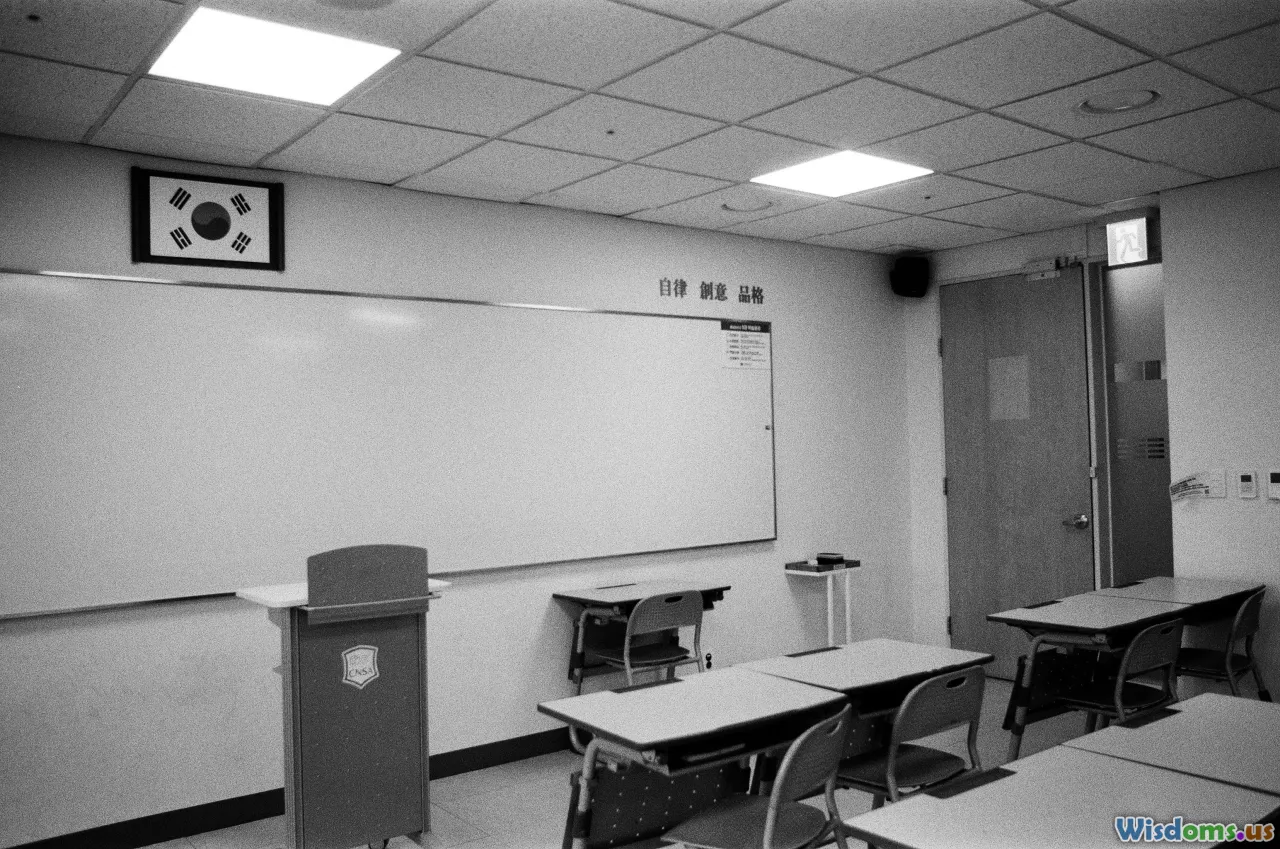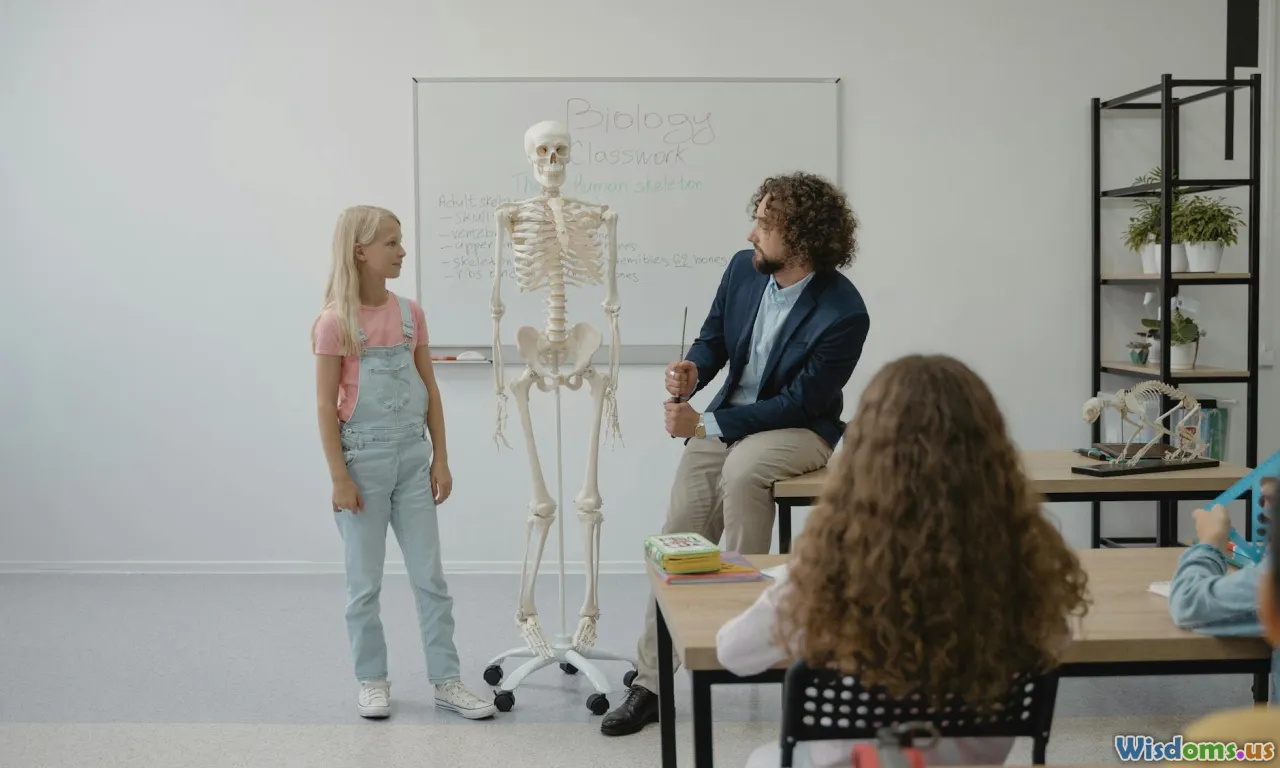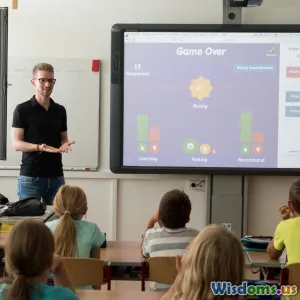
A Teachers Story Transforming Classroom Management Success
34 min read A veteran teacher shares a step-by-step journey from chaos to calm, using routines, restorative practices, and data to transform classroom management and boost engagement, equity, and outcomes. (0 Reviews)
A Teacher’s Story: Transforming Classroom Management Into Lasting Success
On the first Friday of September, Ms. Alvarez sat at her desk after dismissal and stared at the crumpled exit tickets. One student had written a half sentence about states of matter; several had drawn intricate dragons; two were blank. The noise in the room all week had bounced off the walls, and small conflicts flared as often as the Bunsen burners were supposed to. Her lesson plans were solid. Her results were not.
Twelve weeks later, the same class closed their notebooks at the bell with a quiet sense of accomplishment. Their lab groups had debriefed respectfully. Students could recite where to submit their work, how to ask for a lab tool, and when to debate. Disruptions had dipped. Engagement rose. The transformation was not magic. It was intentional, step-by-step work that taught behavior as clearly as content.
This is the story of how Ms. Alvarez rewired her classroom management and what any teacher can borrow from her plan.
What was not working in the first three weeks

On paper, Ms. Alvarez’s eighth-grade science course was beautifully designed. She had phenomenon-based driving questions, a pacing guide, and a schedule of labs that made other teachers envious. But by day 15, patterns emerged:
- Transition losses: It took nearly four minutes to get from seats to lab stations and five minutes to get back. In a 52-minute period, that meant almost 20 minutes a day lost to shifting bodies and finding materials.
- Vague expectations: She had told students to be respectful and responsible, but what did that look like when goggles fogged up or pipettes went missing?
- Reactive corrections: She corrected noise and off-task chatter after it happened, often raising her voice. Students who craved attention learned that disruption worked.
- Uneven relationships: She knew some students well and others by seat number only. Small conflicts snowballed because trust was thin.
She tracked three days of data on a sticky note: tally marks every time she had to stop instruction for behavior. One class hit 17 tallies. That note became the first metric she used to measure progress.
The pivot: co-creating a shared vision

The first change was philosophical and practical: behaviors get taught, rehearsed, and reinforced just like content. On Monday of week four, Ms. Alvarez gave up fifteen minutes to co-create norms.
- She wrote big on the board: Our class runs on safety, respect, and learning.
- She asked: What does respect sound like during lab cleanup? What does safety look like when a beaker breaks? The class brainstormed concrete actions in small groups and shared out.
- They built a behavior matrix with two columns: Learning Tasks (whole-group, independent, lab) and Routines (entering, transitions, cleanup). Under each cell, they listed 2–3 observable actions. For example, cleanup under lab said: return items to labeled bins, wipe station until towel is clean, signal done with hand up and silence.
- She posted the matrix and referred to it daily.
Why did this matter? Clarity reduced interpretation. When students helped define behaviors, buy-in grew. It also created a script for pre-teaching and for positive feedback later. Ms. Alvarez did not assume students automatically knew how to move in a lab; she designed the behavior like she designed her essential questions.
Routines that run themselves

Routines save minutes; minutes become learning. Ms. Alvarez trimmed transition losses with explicit routine instruction over five days. She taught routines like mini-lessons:
- Do Now entry: Students picked up a warm-up card from a bin by the door, sat, and started a short retrieval practice question projected on the board. A soft instrumental track played while the timer counted down 3 minutes. Greeting at the door made this smoother and warmer.
- Threshold greeting: She greeted each student by name and a quick check-in question: On a scale from 1 to 5, how ready are you for labs today? A 2018 study in the Journal of Positive Behavior Interventions found that greeting students at the door increased on-task behavior and reduced disruptions. Ms. Alvarez noticed the same; she also learned who needed a quick support before class started.
- Supply stations: Each table had a labeled caddy. Students in the Materials Manager role collected and returned items. Labels matched the behavior matrix wording to remove guesswork.
- Transitions: She taught a two-part signal for moving between activities: a chime followed by a 10-to-1 countdown. Students practiced moving and freezing at 1. If they made it before 3, the class earned a point toward a Friday lab choice. If not, they practiced again.
- Cleanup: A visual on the projector listed the steps. A timer set for 4 minutes replaced open-ended cleanup time: two minutes for tools, one minute for surfaces, one minute for final check. She narrated the positives during cleanup with behavior-specific praise.
During practice, she did not correct with generalities. Instead of Stop messing around, she used: Return the beaker to the blue bin, then wipe your station until your towel is clean. Teaching specific actions created muscle memory. By week seven, transitions averaged two minutes each; she regained nearly 10 minutes per period.
The power of attention signals that actually work

Noise is not the enemy; unmanaged noise is. Ms. Alvarez replaced her raised-voice pattern with predictable signals:
- Nonverbal signal: A raised hand paired with the call Students, followed by Thank you to acknowledge the first few who paused and looked. She taught and practiced what students did when they saw the signal: stop, look, silent, hands still.
- Chime and countdown: A soft chime, then a calm countdown. The key was consistency. She did not talk over students; she waited. The first week was tough; by the third week, students responded quickly because the signal was reliable.
- Three levels of attention: Level A for full stop and eyes on teacher, Level B for group quiet while continuing to work, Level C for voice-level 1 during labs. The language was posted and used by both teacher and students.
When a student kept talking, Ms. Alvarez used proximity and a silent finger tap on the desk near them rather than a public call-out. She reserved public voice for public praise and group direction. This reduced power struggles and preserved student dignity.
Relationships as the engine: the 2x10 and beyond

Relationships are not a soft add-on; they are the foundation of influence. Ms. Alvarez committed to two strategies:
- The 2x10: Two minutes of conversation with a target student for ten consecutive school days, about the student, not schoolwork. She picked three students who frequently tested boundaries. They talked about sneakers, a younger sibling’s obsession with stuffed animals, a favorite music producer. By day eight, corrections went down with those students, and compliance increased.
- Asset-based language: She reframed descriptors. Instead of calling a student disruptive, she saw an assertive communicator. This helped her assign roles that leveraged those strengths, such as Lab Ambassador who greeted visitors or Group Spokesperson during share-outs.
She also changed her praise habits. Following guidance often shared by Positive Behavioral Interventions and Supports (PBIS) frameworks, she aimed for a 4:1 ratio of behavior-specific praise to corrections. Instead of Good job, she used: I see you returned all materials to the correct bins and wiped your station until the towel was clean. That detailed praise taught the class what to replicate and felt earned, not hollow.
Instructional design that prevents misbehavior

Many classroom management problems are instruction problems in disguise. Bored students make noise. Confused students disengage or act out. Ms. Alvarez made adjustments that had outsized effects:
- Chunked directions: She stopped giving five-step verbal directions. Instead, she projected directions in three steps and checked for understanding after each chunk. Students highlighted key verbs. This prevented the follow-up chorus of What do we do now?
- Choice within tasks: During practice, students could select Option A (diagram and labels) or Option B (short explanation video with notes). Autonomy increased buy-in and reduced off-task behavior, aligning with findings from self-determination theory.
- High-probability sequence: She started with two quick, high-success prompts before a more demanding task. For example, identify the three states of matter, then match examples, then explain a phase change. Early success boosted momentum.
- Retrieval and pacing: Warm-ups drew from prior lessons using low-stakes retrieval. Short, frequent checks for understanding (thumbs-up/sideways/down, mini whiteboards) kept errors visible before they became behavior.
She also built in movement: stand-and-talk pairs every 12 minutes in whole-group instruction. A brief stretch didn’t waste time; it invested it by preventing fidget-fueled disruptions.
Data-driven behavior support without the spreadsheets

Ms. Alvarez continued using her tally metric, but refined it:
- She tracked three things per period on a half-sheet: number of teacher interruptions for behavior, average time for the two major transitions, and one positive classwide behavior to celebrate.
- She created a heat map for behavior spikes. On Mondays, the first ten minutes were rough; on Fridays, cleanup slipped. Awareness drove pre-teaching in those windows.
- She used an ABC snapshot when a behavior repeated: Antecedent (what happened before), Behavior, Consequence (what followed). When a student frequently wandered during labs, she spotted the pattern: wandering occurred after a supply-related delay. Tweaking the Materials Manager routine fixed it.
Data did not require a fancy app, though a simple timer and a printed tracker helped. The goal was to make incremental changes visible. By week eight, her average behavior interruptions dropped from 17 to 6 per period. That feedback loop motivated her and the class.
Restorative responses: fix the harm, keep the relationship

Consequences matter; so do repairs. Ms. Alvarez adopted a restorative approach for non-dangerous misbehavior:
- When a student snapped at a peer, she met with both after class for a quick, structured chat: What happened, who was affected, and what can we do to make it right? The student chose to sit apart for the next discussion and wrote a brief note owning the impact.
- She used reflection forms for repeated minor issues. The form asked: What did I do? What was I trying to get? What could I do next time to get the same need met without breaking a norm?
- Work restoration replaced exclusion for mild missteps. If a student wasted lab time, the consequence was finishing the lab during a preferred activity time later that week, with support if needed.
When safety was at stake, she used clear, consistent consequences aligned to school policy. But even then, she connected with the student afterward, reinforcing that the student belonged in the class community and that the behavior was the problem, not the person.
The physical space: seating, traffic, and tools that help

Designing the room was not cosmetic; it shaped behavior. Ms. Alvarez changed three aspects:
- Seating chart driven by purpose: She placed students who needed frequent teacher feedback near her walking path. Those who modeled self-management anchored table groups. Pairings considered peer relationships and voice levels.
- Traffic lanes: Tape lines on the floor marked a clockwise flow around lab stations. This prevented collisions and the wandering that happens when students aimlessly cross paths. Supply stations were centrally located, reducing back-of-room bottlenecks.
- Visual tools: A projected timer and a magnetic task board showed the current activity. Nonverbal cue cards at the front signaled voice level, attention level, and transition status. A calm-down corner with a 3-minute sand timer offered a brief reset option with teacher approval.
Proximity was her silent ally. She built a habit of circulating during instruction, pausing near hotspots. Often, that was enough to avert trouble without a word.
Technology that supports management, not replaces it

Edtech is a tool, not a plan. Ms. Alvarez used a minimalist tech stack:
- A large visual timer on the screen for transitions and work segments. Students knew how much time they had and adjusted accordingly.
- A randomized name selector for cold-calling, ensuring equity and ending the same three hands answering every question.
- A simple form once a week where students rated class climate on three items: I knew what to do during transitions; I felt respected by peers; I felt that I could get help quickly. She displayed anonymized results and planned tweaks with the class.
She avoided apps that distracted more than they helped. If a tool did not reduce confusion, increase engagement, or make data visible, it did not make the cut.
Working with families and colleagues

Classroom management extends beyond the four walls. Ms. Alvarez made two kinds of partnerships:
- Families: She committed to three positive contacts per week. A quick voicemail or email celebrating a concrete behavior built goodwill. When she needed to discuss a concern later, the relationship was already anchored in positives.
- Colleagues: She visited a veteran teacher’s classroom to watch transitions and borrowed a whiteboard routine. In return, she shared her behavior matrix template. She also coordinated with the counselor to support one student with a check-in/check-out routine.
The impact of these ties was visible in student consistency. Expectations felt the same across science, math, and social studies. Students experienced a supportive network rather than isolated rules.
Measuring progress: what to track and how to celebrate

Change sticks when it is seen. Ms. Alvarez set three goals with the class for the next month:
- Transition to lab stations in under 2 minutes by the second chime at least four days a week.
- Reduce teacher interruptions for behavior to fewer than 8 per period.
- Hit a 90 percent completion rate on exit tickets.
They created a simple scoreboard on a poster. Each day that a goal was met, the class earned a checkmark. Five checks triggered a Friday choice perk: students could select between a short demo, a science video clip, or a game-based review at the end of class. The perks were tied to learning, not candy. The scoreboard made the process feel like a team effort rather than teacher versus students. The act of measuring kept attention on the behaviors they wanted.
A day-in-the-life snapshot: before and after

Before
- 0:00 Bell rings as students push in noisily. Some drop bags, others ask where to sit. Warm-up slides are overshadowed by chatter.
- 4:00 Ms. Alvarez tries to start; three students keep talking. She raises her voice. One student doodles; another heads to the back for a pen and gets distracted.
- 10:00 Transition to lab takes five minutes. Students wander to find supplies. A spill draws half the class’s attention.
- 25:00 Noise climbs. Ms. Alvarez stops the class to reset; it takes two minutes to get quiet. Off-task behavior spreads.
- 45:00 Cleanup begins late. Students do not know where everything belongs. The bell rings with stations still messy.
After
- 0:00 Students enter, grab the warm-up, and begin in a low hum. Ms. Alvarez greets each student. A timer counts down the three-minute retrieval practice.
- 3:00 Chime and countdown. Students turn their attention. Ms. Alvarez reviews the lab steps with three projected directions and checks for understanding with a quick thumbs-in.
- 8:00 Transition signal. Materials Managers retrieve caddies. A clockwise flow prevents collisions. Ms. Alvarez narrates positives and moves among groups.
- 15:00 Groups engage with roles: Manager, Recorder, Spokesperson, and Safety Monitor. A student begins to wander; proximity and a gentle nonverbal cue redirect them. Noise stays at Level C.
- 38:00 Ms. Alvarez signals cleanup with a four-step visual and a timer. Students head to bins, wipe, and sit with a hand up. She praises specific groups that finish early with fidelity.
- 45:00 Two-minute debrief and exit ticket. Students submit work to a tray labeled by period, then pack up quietly. The bell rings as the last hand drops.
The difference is not only quieter sound; it is purposeful movement and clear roles. The learning is visible in notebooks and confident voices.
Troubleshooting common setbacks

Even with the best plan, human beings bring variables. Here are common snags Ms. Alvarez hit and how she solved them:
- Students ignore the attention signal: She taught and rehearsed it again, then used a brief classwide incentive tied to fidelity. For two days, she set a micro-goal: all eyes and silence by 3 in the countdown. If the class hit it, two groups earned a choice in lab partners. The quick focus on mastery re-established the habit.
- One student dominates group talk: She created a role rotation and a speaking token system. Each student received two tokens; to speak, they slid a token in. When tokens were gone, they shifted to a recorder role. This balanced voices.
- Chronic tardiness: She moved the warm-up to a quick partner check. Late students could get the gist from their partner without whole-class rewind. She also set up friendly check-ins with the counselor and family for the three most frequent late arrivals.
- Mid-unit slump: She inserted a short, high-engagement demonstration in the middle of the period and a stand-and-share afterwards. The novelty bump lifted energy and lowered side chatter.
- Escalation when corrected: She prepared calm scripts. Instead of a lecture, she used: I hear you. We will talk after the lab. For now, return the beaker to the blue bin and join your group. She reduced public back-and-forth. Later, in private, she discussed the pattern and brainstormed alternatives with the student.
The long game: sustaining change without burning out

Classroom management gains fade if the teacher is exhausted. Ms. Alvarez protected her energy:
- She prioritized three key routines each week rather than chasing ten. Once they were automatic, she added another.
- She built short scripts for corrections and practiced them. Decision fatigue dropped.
- She chose one data point to track at a time. After behavior interruptions improved, she tracked time-on-task during independent work using quick scans at 5-, 15-, and 30-minute marks.
- She gave herself permission to reset routines midyear. She framed it with students: We learned a lot. Now we are ready for the next level of independence. Let’s update our norms.
- She shared the load through student jobs. Roles included Materials Manager, Tech Captain, Timekeeper, Ambassador, and Librarian. Jobs rotated weekly. Responsibility became part of the culture.
This work was not about a perfect day; it was about progress and systems that carried the class when energy dipped.
A practical toolkit: templates and scripts Ms. Alvarez used

Behavior matrix starter
- Entering the room: Enter quietly, pick up warm-up, sit in assigned seat, begin.
- Whole-group instruction: Eyes on speaker, voice off, materials closed unless instructed, track with your finger.
- Independent work: Voice level 0–1, questions on sticky note or raise hand, stay in seat.
- Labs: Voice level 2–3, move clockwise, safety goggles on, roles in action.
- Cleanup: Return to labeled bins, wipe until towel is clean, hand up and silent.
Sample behavior-specific praise
- I noticed you started the warm-up within ten seconds and showed your work on both questions.
- You and your partner moved clockwise and waited for the group ahead before getting supplies.
- Thank you for using Level B voices during the video; that helped everyone hear the instructions.
Correction scripts
- Immediate, non-escalating: Right now, voices at Level B. Thank you, table three.
- Private redirect: When you are ready, return to your group and start step two. I will check back in two minutes.
- Reset with choice: You can complete the notes at your seat or at the back table. Which helps you focus?
Reflection prompt
- What happened? What were you trying to accomplish? What were two other choices you could have made? What is your plan next time?
Two-week rollout plan for a new routine
- Day 1–2: Model and practice. Narrate positives. Use the timer to bound the practice.
- Day 3: Practice with stakes. Set a small class goal tied to fidelity. Celebrate.
- Day 4–5: Embed in instruction. Correct quietly. Keep praising specifically.
- Week 2: Tighten timing by 10–20 percent. Invite student feedback. Adjust.
Results after twelve weeks: what changed

By the end of the second quarter, Ms. Alvarez’s data told the story:
- Behavior interruptions dropped from an average of 17 per period to 5–6.
- Transition times shrank, regaining about 8–10 minutes per class.
- Exit ticket completion rose from roughly 60 percent to over 90 percent.
- Student climate surveys improved. More students agreed with the statements I know what to do during transitions and I can get help quickly.
More importantly, the tone of the room shifted. Students laughed appropriately, debated respectfully, and held one another to norms they helped shape. The same student who once wandered during labs now served as a Lab Ambassador. Another who bristled at correction became a steady Recorder who ensured data accuracy for the group. The classroom no longer ran on the teacher’s willpower alone; it ran on shared systems and shared ownership.
Why this story matters: principles you can adapt tomorrow

No two classrooms are identical, but the principles that guided Ms. Alvarez travel well.
- Teach behavior like content. Model, practice, and reinforce specific actions for routines and learning tasks.
- Prioritize relationships. Use small, consistent investments like the 2x10 strategy and asset-based roles.
- Use predictable signals and levels. Avoid shouting. Train the class to respond to a few consistent cues.
- Design instruction to prevent problems. Clear directions, choices, movement, and frequent checks reduce off-task time.
- Track one or two data points. Let evidence guide tweaks. Celebrate progress publicly.
- Repair and restore. When harm happens, fix it with structured conversations and work restoration instead of default exclusion.
- Share responsibility. Student jobs and co-created norms build ownership.
Choose one routine to rebuild this week. Script it, teach it, and practice it with your class. Tap a colleague to watch and give feedback. If you greet your students at the door, set a classwide goal for transitions, and aim for a 4:1 praise-to-correction ratio, you will feel the difference within two weeks.
Every teacher has a story about classroom management. Let yours be the one where the room shifts from chaos to community, where science labs hum with productive noise, and where students learn not only content but how to learn together. The day Ms. Alvarez noticed the dragons had disappeared from exit tickets and been replaced by accurate particle diagrams, she smiled. The systems were working. The students were learning. And she was, too.
Psychology Student Engagement Education Teaching Strategies positive reinforcement Classroom Management Educational Psychology Data Tracking K-12 Teaching Classroom routines Restorative practices Behavior management Trauma-informed teaching MTSS PBIS SEL Family partnerships Multilingual learners IEPs Seating charts
Rate the Post
User Reviews
Popular Posts



















